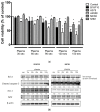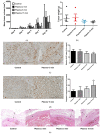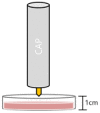Anticancer Effect of Cold Atmospheric Plasma in Syngeneic Mouse Models of Melanoma and Colon Cancer
- PMID: 37241912
- PMCID: PMC10224096
- DOI: 10.3390/molecules28104171
Anticancer Effect of Cold Atmospheric Plasma in Syngeneic Mouse Models of Melanoma and Colon Cancer
Abstract
Cold atmospheric plasma (CAP) may have applications in treating various types of malignant tumors. This study assessed the anticancer effects of CAP using melanoma and colon cancer cell lines. CAP treatment significantly reduced the in vitro viability of melanoma and colon cancer cell lines and had a negligible effect on the viability of normal human melanocytes. Additionally, CAP and epidermal growth factor receptor (EGFR) inhibitor had an additive anticancer effect in a CAP-resistant melanoma cell line. Reactive oxygen and nitrogen species known to be generated by CAP enhanced the anticancer effects of CAP and EGFR inhibitors. The in vivo anticancer activities of CAP were evaluated by testing its effects against syngeneic tumors induced in mice by melanoma and colon cancer cells. CAP treatment reduced tumor volume and weight in both cancer models, with the extent of tumor reduction dependent on the duration and number of CAP treatments. Histologic examination also revealed the tumoricidal effects of CAP in both tumor models. In conclusion, CAP inhibits the growth of mouse melanoma and colon cancer cell lines in vitro and shows tumoricidal effects against mouse models of melanoma and colon cancer in vivo.
Keywords: cancer treatment; cold atmospheric plasma; colon cancer; melanoma; syngeneic mouse model.
Conflict of interest statement
The authors declare no conflict of interest.
Figures








Similar articles
-
Cold atmospheric plasma and silymarin nanoemulsion synergistically inhibits human melanoma tumorigenesis via targeting HGF/c-MET downstream pathway.Cell Commun Signal. 2019 May 24;17(1):52. doi: 10.1186/s12964-019-0360-4. Cell Commun Signal. 2019. PMID: 31126298 Free PMC article.
-
Cold atmospheric pressure plasma treatment combined with starvation increases autophagy and apoptosis in melanoma in vitro and in vivo.Exp Dermatol. 2022 Jul;31(7):1016-1028. doi: 10.1111/exd.14544. Epub 2022 Feb 26. Exp Dermatol. 2022. PMID: 35181947
-
Killing malignant melanoma cells with protoporphyrin IX-loaded polymersome-mediated photodynamic therapy and cold atmospheric plasma.Int J Nanomedicine. 2017 May 31;12:4117-4127. doi: 10.2147/IJN.S129266. eCollection 2017. Int J Nanomedicine. 2017. PMID: 28615940 Free PMC article.
-
Synergistic effects of cold atmospheric plasma and doxorubicin on melanoma: A systematic review and meta-analysis.Sci Rep. 2025 Mar 6;15(1):7870. doi: 10.1038/s41598-025-90508-z. Sci Rep. 2025. PMID: 40050300 Free PMC article.
-
Use of cold atmospheric plasma in the treatment of cancer.Biointerphases. 2015 Jun 19;10(2):029403. doi: 10.1116/1.4915264. Biointerphases. 2015. PMID: 25791295 Review.
Cited by
-
Advances in cold atmospheric plasma therapy for cancer.Bioact Mater. 2025 Jul 25;53:433-458. doi: 10.1016/j.bioactmat.2025.07.031. eCollection 2025 Nov. Bioact Mater. 2025. PMID: 40747454 Free PMC article. Review.
-
A Hiplot-based web service for cold atmospheric plasma high-throughput data integration and analysis on breast cancer.Imeta. 2025 May 25;4(4):e70045. doi: 10.1002/imt2.70045. eCollection 2025 Aug. Imeta. 2025. PMID: 40860433 Free PMC article.
-
Efficacy of Cold Atmospheric Plasma vs. Chemotherapy in Triple-Negative Breast Cancer: A Systematic Review.Int J Mol Sci. 2024 Mar 13;25(6):3254. doi: 10.3390/ijms25063254. Int J Mol Sci. 2024. PMID: 38542225 Free PMC article.
-
Cold Atmospheric Plasma in Oncology: A Review and Perspectives on Its Application in Veterinary Oncology.Animals (Basel). 2025 Mar 27;15(7):968. doi: 10.3390/ani15070968. Animals (Basel). 2025. PMID: 40218360 Free PMC article. Review.
-
Innovative Therapeutic Approach Targeting Colon Cancer Stem Cells: Transitional Cold Atmospheric Plasma.ACS Omega. 2025 Mar 6;10(12):12109-12121. doi: 10.1021/acsomega.4c10378. eCollection 2025 Apr 1. ACS Omega. 2025. PMID: 40191350 Free PMC article.
References
-
- Moon I.J., Won C.H. Review of the current state of medical plasma technology and its potential applications. Med. Lasers. 2018;7:1–5. doi: 10.25289/ML.2018.7.1.1. - DOI
-
- Weiss M., Gümbel D., Hanschmann E.-M., Mandelkow R., Gelbrich N., Zimmermann U., Walther R., Ekkernkamp A., Sckell A., Kramer A., et al. Cold atmospheric plasma treatment induces anti-proliferative effects in prostate cancer cells by redox and apoptotic signaling pathways. PLoS ONE. 2015;10:e0130350. doi: 10.1371/journal.pone.0130350. - DOI - PMC - PubMed
-
- Hwang S.G., Kim J.H., Jo S.Y., Kim Y.J., Won C.H. Cold atmospheric plasma prevents wrinkle formation via an antiaging process. Plasma Med. 2020;10:91–102. doi: 10.1615/PlasmaMed.2020034810. - DOI
MeSH terms
Substances
Grants and funding
LinkOut - more resources
Full Text Sources
Medical
Research Materials
Miscellaneous

